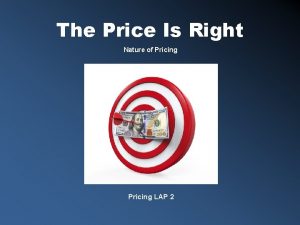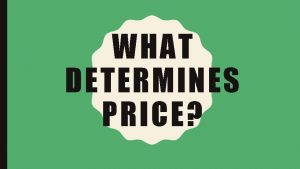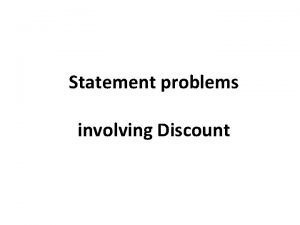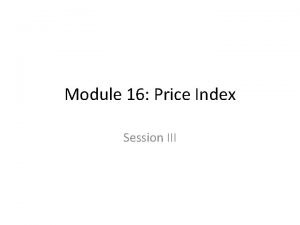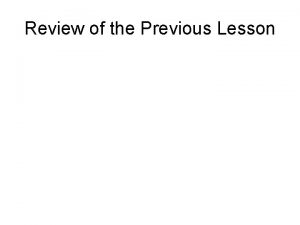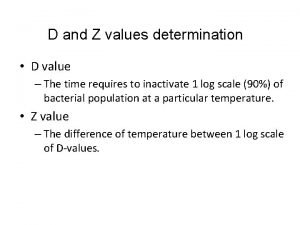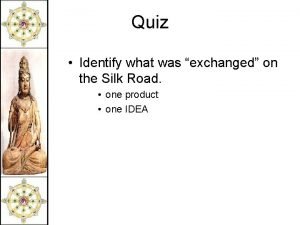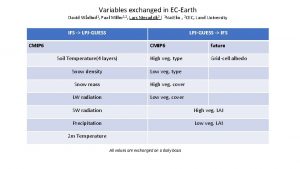The Nature of Price Price The value exchanged


















- Slides: 18

The Nature of Price • Price – The value exchanged for products in a marketing exchange • Barter – The trading of products; the oldest form of exchange • Terms Used to Describe Price – Tuition, premium, fine, fee, fare, toll, rent, commission, dues, deposit, tips, interest, taxes Copyright © Houghton Mifflin Company. All rights reserved. 1

The Nature of Price (cont’d) • The Importance of Price to Marketers – It is the most readily changeable characteristic (under favorable circumstances) of a product. • Have a sale! Lower priced (“value”) menu. – It is a key element in the marketing mix because it relates directly to generation of revenues and quantities sold. – It is a key component of the profit equation, having strong effect on the firm’s profitability. – It has symbolic value to customers—prestige pricing. Profit = Total Revenues - Total Costs Profits = (Price x Quantity Sold) - Total Costs Copyright © Houghton Mifflin Company. All rights reserved. 2

Price and Nonprice Competition • Price Competition – Emphasizing price and matching or beating competitors’ prices • Circuit City – “we’ll pay the difference if competitors have a lower price” • Priceline. com • http: //www. adcritic. com/content/priceline-uncanny. html – An effective strategy in markets with standardized products • Airfare wars – Lowest-cost competitor (seller) will be most profitable. • Southwest Airlines, Walmart • http: //www. adcritic. com/content/southwest-recess. html – Allows marketers to respond quickly to competitors • If one airline cuts prices, competition will match. – Price wars can weaken competing organizations. • Low profit margins…SWA vs. Continental Express Copyright © Houghton Mifflin Company. All rights reserved. 3

Price and Nonprice Competition (cont’d) • Nonprice Competition – Emphasizing factors other than price to distinguish a product from competing brands • Distinctive product features • Service • Product quality • Promotion • Packaging • http: //www. adcritic. com/content/delta-the_seat. html – Is effective when a product or service’s features are difficult to imitate by competitors and customers perceive their value • Can image/product of Nike be imitated? – Builds customer loyalty by focusing on nonprice features • Performance • http: //www. adcritic. com/content/honda-cog. html Copyright © Houghton Mifflin Company. All rights reserved. 4

Analysis of Demand • The Demand Curve – A graph of the quantity of products expected to be sold at various prices – Decreases in price create increases in quantities demanded. – Increased demand means larger quantities sold at the same price. – Must monitor other elements of marketing mix! • Price is not the only influencer of demand. • Quality, promotion, distribution, etc. – Prestige items sell best in higher price ranges. Copyright © Houghton Mifflin Company. All rights reserved. 5

Elasticity of Demand • Price Elasticity – A measure of the sensitivity of demand to changes in price—the greater the change in demand for a specific change in price, the more elastic demand is – In other words: • Heating oil vs. sports cars Copyright © Houghton Mifflin Company. All rights reserved. 6

Elasticity of Demand FIGURE 20. 3 Copyright © Houghton Mifflin Company. All rights reserved. 7

Analysis of Demand (cont’d) • Reasons for Demand Fluctuations – Changes in buyers’ needs – Variations in the effectiveness of the marketing mix – The presence of substitutes – Dynamic environmental/market factors Price Elasticity of Demand Copyright © Houghton Mifflin Company. All rights reserved. = % Change in Quantity Demanded % Change in Price 8

Important Terms • Marginal Revenue – The change in total revenue resulting from the sale of an additional unit of product • Fixed Costs – Costs that do not vary with changes in the units produced or sold • Rental of retail space • Average Fixed Cost – The fixed cost per unit produced • % of rental cost in each unit • Variable Costs – Costs that vary directly with changes in the number of units produced or sold • Hiring extra salespeople for xmas season Copyright © Houghton Mifflin Company. All rights reserved. 9

Determining the Breakeven Point FIGURE 20. 7 Copyright © Houghton Mifflin Company. All rights reserved. 10

Factors That Affect Pricing Decisions FIGURE 20. 8 Copyright © Houghton Mifflin Company. All rights reserved. 11

Factors Affecting Pricing Decisions • Organizational and Marketing Objectives – Prices should be set that are consistent with the organization’s goals and mission. • E. g. , service, quality, etc. – Prices must be compatible with marketing objectives • e. g. , setting premium prices to enhance a product’s quality image. • Types of Pricing Objectives – Setting prices low to increase market share – Using temporary price reductions to gain market share – Lowering prices to raise cash quickly Copyright © Houghton Mifflin Company. All rights reserved. 12

Factors Affecting Pricing Decisions (cont’d) • Costs – Set a floor price—products must be sold above their costs if the firm is to remain in business. • Dealer cost? – Reducing costs increases productivity and profitability. • Using labor-saving technologies • Focusing on quality • Establishing efficient manufacturing processes • Other Marketing Mix Variables – Price/quality image of the product or brand – Selective or intensive product distribution – Product pricing used as a promotional tool Copyright © Houghton Mifflin Company. All rights reserved. 13

Factors Affecting Pricing Decisions (cont’d) • Channel Member Expectations – To make a profit at least equivalent to the potential profit from handling a competitor’s brand • Kraft vs. Wishbone vs. Kens – To receive discounts for volume purchases and prompt payment • Drop shipments – To be supported by the producer with training, advertising, sales promotion, and return policies • In-store displays Copyright © Houghton Mifflin Company. All rights reserved. 14

Factors Affecting Pricing Decisions (cont’d) • Customers’ Interpretation and Response – What meaning does the product’s price have to the customer? • Perceptual pricing: $3. 99 = 4. 00? 2 for $1. 00? – Does the customer respond to the price by moving closer to or farther away from making a purchase? – Internal reference price • A price developed in the buyer’s mind through experience with the product – External reference price • A comparison price provided by others Copyright © Houghton Mifflin Company. All rights reserved. 15

Factors Affecting Pricing Decisions (cont’d) • Buyers’ responses to price – Value consciousness • Concern about price and quality – Price consciousness • Striving to pay low prices – Prestige sensitivity • Being drawn to products that signify prominence and status • Willing to pay higher price Copyright © Houghton Mifflin Company. All rights reserved. 16

Factors Affecting Pricing Decisions (cont’d)Price Discounting (cont’d) • Competition – Pricing to match competitors’ prices • Then compete on nonprice – Judging competitors’ responses to adjusting prices • What will Verizon due if Sprint lowers prices? – Changes in an industry’s market structure cause and create pricing opportunities. • Monopoly vs. perfect competition • Cable vs. athletic shoes • Legal and Regulatory Issues – Price controls intended to curb inflation --- California? Arnold? – Controls that set/regulate prices for specific products – Regulations and laws to prohibit price fixing, and deceptive and discriminatory pricing Copyright © Houghton Mifflin Company. All rights reserved. 17

Extra credit assignment! • 5 points! You NEED these! • Go to blackboard for course (9: 30 = section 2, 1: 00 = section 3) • Take survey posted on “assignments” • When finished, BEFOR clicking “submit”, print out survey, bring to class 10/21. • Print out “Thank you” acknowledgement • Print out e-mail receipt. • http: //www. business. ecu. edu/users/venableb/surv ey/ Copyright © Houghton Mifflin Company. All rights reserved. 18
 Islamic traders exchanged _____ with africans for gold.
Islamic traders exchanged _____ with africans for gold. Ano ibig sabihin ng price floor
Ano ibig sabihin ng price floor Penciptaan nilai adalah
Penciptaan nilai adalah Nature and nature's law lay hid in night meaning
Nature and nature's law lay hid in night meaning Nature nature controversy
Nature nature controversy What is the nature of price
What is the nature of price Nature of price
Nature of price Nature of price
Nature of price Joel feinberg the nature and value of rights
Joel feinberg the nature and value of rights Marked price-selling price=
Marked price-selling price= Disadvantages of hire purchase
Disadvantages of hire purchase Bulk material flow enhancement
Bulk material flow enhancement Price discovery and price determination
Price discovery and price determination Simple aggregate price index formula
Simple aggregate price index formula Expected value and fair price
Expected value and fair price Does providing a good value mean selling at a low price?
Does providing a good value mean selling at a low price? In the previous lesson i learned that accounting
In the previous lesson i learned that accounting P value fomula
P value fomula D value and z value
D value and z value






